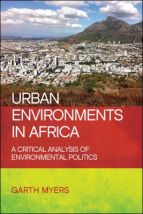Urban Environments in Africa: A Critical Analysis of Environmental Politics

Urban Environments in Africa attempts to fill what Garth Myers argues is a gap in scholarship: marrying environmental and urban studies in African contexts. The book mainly discusses cities with more than 500,000 inhabitants, all the way up to the megacities Cairo and Lagos. It covers a range of cities from across the continent, while recognizing the diversity of this range. And it adopts urban political ecology as its theoretical framework, attempting to build on a tradition of rural political ecology in Africa.
Myers describes five options for understanding urban environments in Africa, which show the many perspectives calling for recognition. These five options are:
- “The experts” (taking a scholarly or scientific approach)
- “The past” (analysing how colonialism and other historical circumstances have affected African urban environments)
- “The cityscape” (focusing on the physical, social and cultural dimensions of African cities)
- “The artists” (seeing how musicians, writers, and other artists view these environments)
- “The grassroots” (examining the work of African social movements and community organizations)
For example, the chapter on “the artists” analyses novels that show different conceptions of urban waste in Africa, from waste collection as a livelihood to festering waste as a symbol of government neglect. It also describes the rapper–activists in Dakar who speak out about the lack of environmental services, such as garbage and sanitation. These highlight “the crucial role of spectacular art/activism in provoking revolutionary thought…activist artists and writers are challenging the received wisdom about urban environments in Africa, as they have been for at least a century” (page 138).
After exploring each of the five options in turn, Myers explains that this “interactionist map” is needed for Africa’s diverse and contested urban spaces. And he gives examples of how this multifaceted understanding can be translated into practice.
One is the Kibera Public Space Project in Nairobi, a joint effort of the US-based planning non-profit Kounkuey Design Initiative (KDI) and six communities in Kibera. This public place-making collaboration integrates “the experts” through technical planning expertise, “the past” through knowledge of a location’s history, “the cityscape” through “a rich collaborative conception of both the physical and the spiritual dimensions of the Kibera landscape”, “the artists” through integration of creative work, and “the grassroots” through the very nature of the project (page 166).
Efforts like the Kibera Public Space Project’s are, in this analysis, part of “radical incrementalism” – or small actions that contribute to fairer and more sustainable African cities. Myers’ belief is that moving away from absolutes and dramatic swings is more in tune with the complexity of these spaces, where little-by-little change can add up to a great deal.
Further reading:
Angelo, Hillary and David Wachsmuth (2015), “Urbanizing Urban Political Ecology: A Critique of Methodological Cityism”, International Journal of Urban and Regional Research Vol 39, No 1, pages 16–28, available at http://www.urbantheorylab.net/site/assets/files/1146/angelo_and_wachsmut....
Kozain, Rustum (2014), “A Brief History of Throwing Shit”, The Chronic, 19 May, available at http://chimurengachronic.co.za/shit-throwing/.
Roberts, Debra and Sean O’Donoghue (2013), “Urban environmental challenges and climate change action in Durban, South Africa”, Environment and Urbanization Vol 25, No 2, pages 299–319, available at http://journals.sagepub.com/doi/full/10.1177/0956247813500904.
Watson, Vanessa (2013), “African urban fantasies: dreams or nightmares?”, Environment and Urbanization Vol 26, No 1, pages 215–231, available at http://journals.sagepub.com/doi/full/10.1177/0956247813513705.
Book note prepared by Christine Ro
Search the Book notes database
Our Book notes database contains details and summaries of all the publications included in Book notes since 1993 - with details on how to obtain/download.
Use the search form above, or visit the Book notes landing page for more options and latest content.
For a searchable database for papers in Environment and Urbanization, go to http://eau.sagepub.com/

